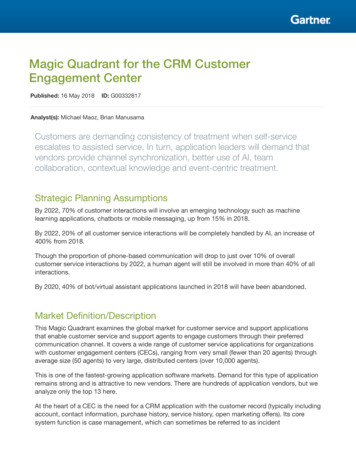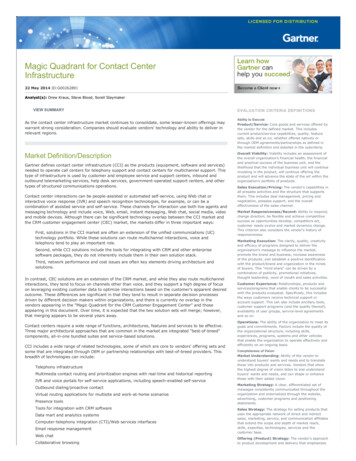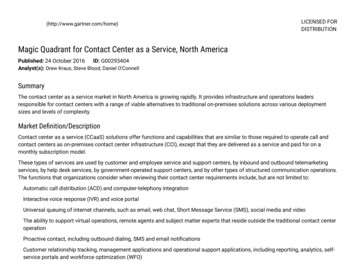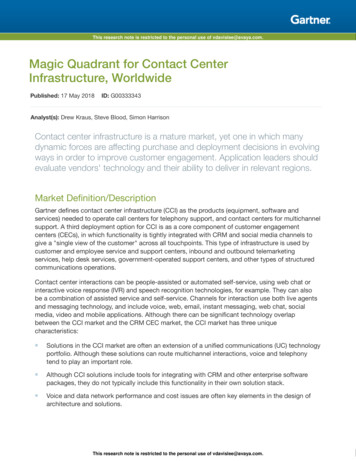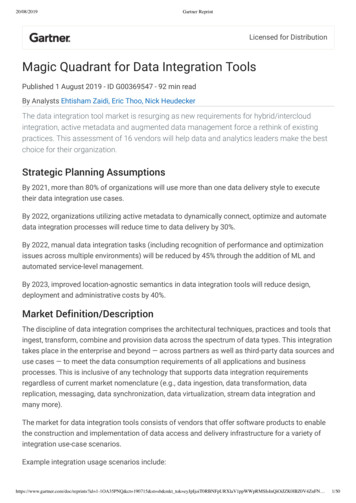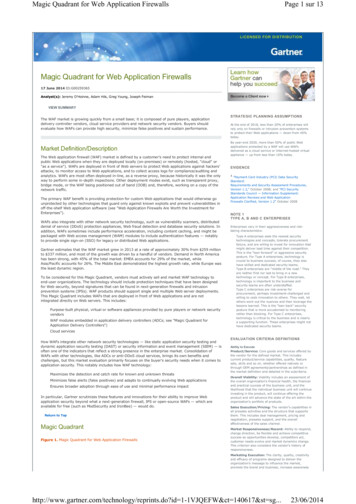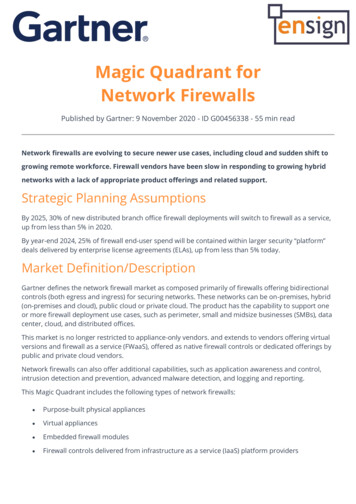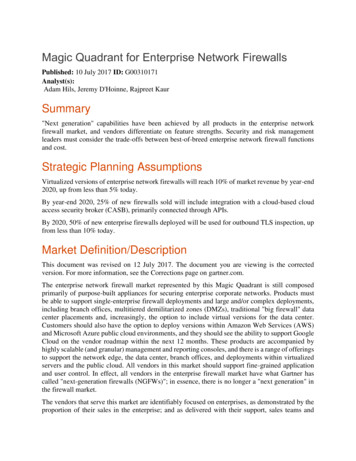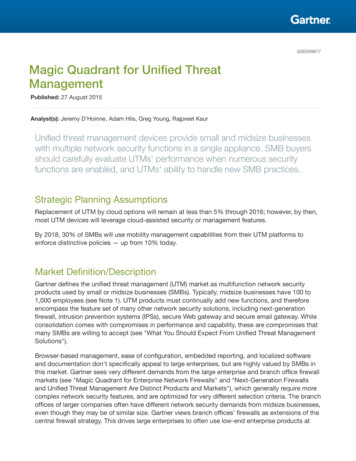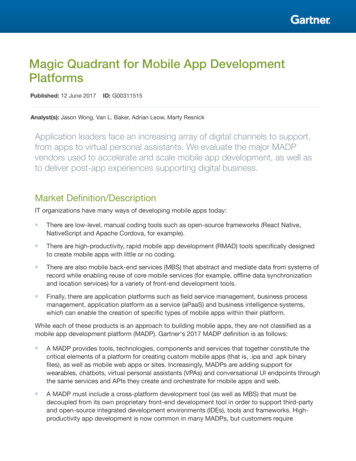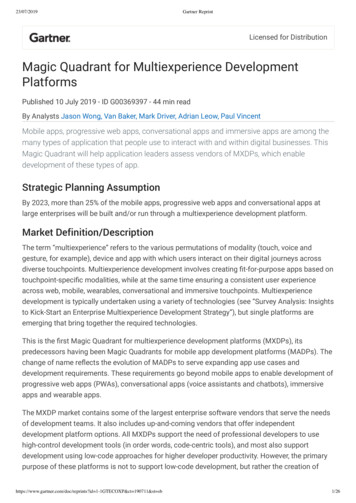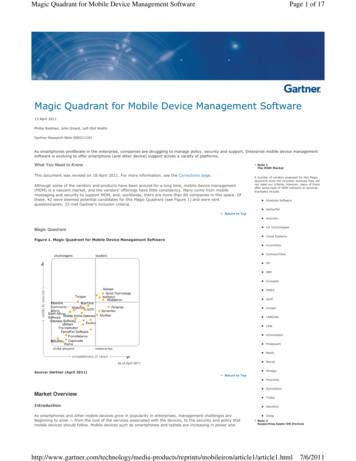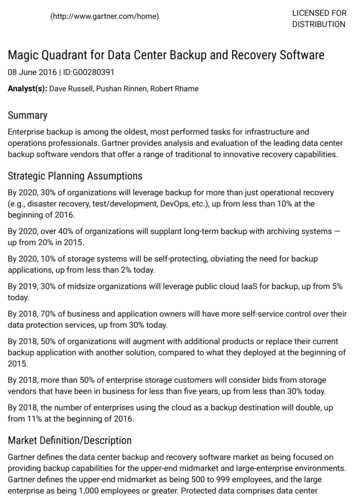
Transcription
(http://www.gartner.com/home)LICENSED FORDISTRIBUTIONMagic Quadrant for Data Center Backup and Recovery Software08 June 2016 ID:G00280391Analyst(s): Dave Russell, Pushan Rinnen, Robert RhameSummaryEnterprise backup is among the oldest, most performed tasks for infrastructure andoperations professionals. Gartner provides analysis and evaluation of the leading data centerbackup software vendors that offer a range of traditional to innovative recovery capabilities.Strategic Planning AssumptionsBy 2020, 30% of organizations will leverage backup for more than just operational recovery(e.g., disaster recovery, test/development, DevOps, etc.), up from less than 10% at thebeginning of 2016.By 2020, over 40% of organizations will supplant long-term backup with archiving systems —up from 20% in 2015.By 2020, 10% of storage systems will be self-protecting, obviating the need for backupapplications, up from less than 2% today.By 2019, 30% of midsize organizations will leverage public cloud IaaS for backup, up from 5%today.By 2018, 70% of business and application owners will have more self-service control over theirdata protection services, up from 30% today.By 2018, 50% of organizations will augment with additional products or replace their currentbackup application with another solution, compared to what they deployed at the beginning of2015.By 2018, more than 50% of enterprise storage customers will consider bids from storagevendors that have been in business for less than five years, up from less than 30% today.By 2018, the number of enterprises using the cloud as a backup destination will double, upfrom 11% at the beginning of 2016.Market Definition/DescriptionGartner defines the data center backup and recovery software market as being focused onproviding backup capabilities for the upper-end midmarket and large-enterprise environments.Gartner defines the upper-end midmarket as being 500 to 999 employees, and the largeenterprise as being 1,000 employees or greater. Protected data comprises data center
workloads, such as file share, file system, operating system, database, email, contentmanagement, CRM, ERP and collaboration application (such as content managementsolutions) data. Today, these workloads are largely on-premises; however, protecting SaaSapplications (such as Salesforce and Microsoft Office 365) and infrastructure as a service(IaaS) is becoming increasingly important, as are other, newer "born in the public, private orhybrid cloud" applications.Provider solutions that primarily address backup and recovery of remote office, smallenterprise, individual system and/or an endpoint device data are outside of the scope of thisdata-center-oriented focus. Some providers may, however, also address these workloads, aswell as the larger data center workloads described above. However, those are not the primaryuse cases for deploying these data center solutions.These backup and recovery software products provide features such as traditional backup totape, backup to conventional random-access media (such as a hard disk or solid-state drives)or devices that emulate the previous backup targets (such as virtual tape library [VTL]), datareduction (such as compression, deduplication or single instancing), array and/or serverbased snapshot, heterogeneous replication, and continuous data protection (CDP).Additionally, integration and exploitation of the cloud, particularly the public cloud, as a backuptarget or to a colocation facility are becoming more important for backup workloads.These solutions may be provided as software-only, or as an integrated appliance that containsall of — or substantial components of — the backup application, such as the master server or amedia server (something beyond a backup agent, or preparsing code that is used fordedicated backup target devices).As the backup and recovery software market has dozens, if not hundreds, of vendors, thisreport narrows the focus down to those that have a very strong presence worldwide in theupper-end midmarket and large-enterprise environments.Solutions that are predominantly sold as a service (backup as a service [BaaS]) do not meetthe market definition for the data center backup and recovery software market. Backupsoftware for a homogeneous environment, such as native tools from Microsoft or VMware fortheir own specific platforms, is also excluded, as many midsize and large customers prefer asingle, scalable backup product for their entire environment.This 2016 "Magic Quadrant for Data Center Backup and Recovery Software" is a refocus andupdate to the "Magic Quadrant for Enterprise Backup Software and Integrated Appliances" thatwas last published in June 2015. The renamed Magic Quadrant and updated market criteriaare in response to Gartner client requests to focus more on backup and recovery software forthe upper-midsize to large enterprises that protect data center workloads managed by datacenter personnel.Magic QuadrantFigure 1. Magic Quadrant for Data Center Backup and Recovery Software
Source: Gartner (June 2016)Vendor Strengths and CautionsActifioActifio is an emerging data protection vendor whose innovative solution offers afundamentally different way to do backup. The solution uses application-aware plug-ins tocapture backup data with a block-level incremental-forever method. Backup data is stored inthe native format in a snapshot pool for very fast recovery, and separately preserved in adeduplicated pool for local retention and remote replication. While all its customers useActifio's solution to replace traditional backup, the vast majority also use it for disasterrecovery and business continuity within a hybrid cloud. Increasingly, nearly half of itscustomers are also exploring the virtual copy functionality for test/development. Actifioreported over 1,200 enterprise customers by the end of its latest fiscal year (end of January
2016), with the majority using Actifio's subscription license option. Actifio is facingcompetition from other emerging vendors with a similar architecture and from traditionalvendors that continue to improve performance.STRENGTHSActifio's solution offers much faster backup and recovery than traditional backup methods,augmented by SLA-based management policies to simplify initial configurations.Many enterprises have used the solution for backup and disaster recovery, as well as toenable DevOps agility and structured data archiving.Among emerging vendors offering a similar architecture, Actifio has the broadest hostsupport matrix and data management functions.CAUTIONSSome customers cited potential high cost of storage, as the snapshot pool in Actifio'sphysical appliances doesn't offer compression.Actifio backup users may require collaboration and buy-in from other constituents, such asdatabase/application administrators and the disaster recovery team, to fully realize "copydata management" benefits.Actifio doesn't natively offer bare-metal restore capabilities.ArcserveArcserve has two backup products in its portfolio: Arcserve Backup r17 (legacy offering) andArcserve Unified Data Protection (UDP).The company generates its growth from the newerUDP solution, which is the strategic platform and is offered as software or as an appliance.Arcserve has been on a journey to further unify backup capabilities and offer a single point ofmanagement for UDP. In the past year, unified tape management and a new installedstreamlined product feature have been added to UDP. Arcserve Backup has added SAP Hanasupport, and the ability to write compressed and deduplicated data to tape has been delivered.The company is especially focused on addressing the backup needs of the upper-midsize anddecentralized large-enterprise markets. Organizationally, Arcserve has been looking tostrengthen its channels and alliances, and has brought in additional industry veterans to leadits development efforts. Now approaching the two-year mark after the split from CATechnologies, sales are improving, and the vendor is seeing greater traction from the UDPsolution, with almost half of its active customers having migrated to the new platform.Arcserve has particularly strong presence in EMEA and Japan.STRENGTHSArcserve offers protection capabilities that range from traditional backup to continuous dataprotection (CDP), has begun delivery snapshot support, initially with NetApp and NimbleStorage supported.Arcserve offers an Assured Recovery capability via its high availability option that canleverage virtual standby and instant-access virtual machine (VM) options, or via its ArcserveCloud Disaster Recovery as a Service (DRaaS) option, to provider broader data access.
Flexible packaging and pricing options make it easy to only purchase required features, withthe ability to pay by the processor socket, terabyte or operating system instance, and todeploy as software or as a branded, integrated appliance.CAUTIONSArcserve may require further validation for very large enterprise deployments, as the vendoris most typically deployed in the midsize to upper-midsize enterprises.Full integration of features, such as physical tape support, into the UDP product andadministration console remains a work in progress.No automatic load balancing of backups or restores across available resources means thatlarger operations could require more tuning.CommvaultCommvault's investment in R&D is evident as it has added support for new hypervisors, publiccloud IaaS, SaaS and storage arrays in rapid succession. Commvault now supports a growinglist of cloud and hypervisors, and facilitates agnostic conversion from physical, to virtual, tocloud and back for complete interoperability among them. IntelliSnap offers the sameportability across the industry's broadest list of supported storage arrays. This provides aflexibility that is more than the sum of the parts, given the expansive support matrix. Theresult is that procurement decisions made today regarding storage arrays, hypervisors or eventhe cloud are not lock-ins for tomorrow. Commvault has introduced a scale-out softwaredefined storage (SDS) back end with built-in indexing and data reduction/optimization, whichis available as a storage target for other applications. After achieving success with its bundlesand responding to market pressures, Commvault has completed a second stage of pricingrevision to get rid of its reputation as an expensive vendor, and convert to a customer-friendly,net-price maintenance model. Customer support and satisfaction feedback remain veryfavorable, and over the past year, Commvault has again made product enhancements thatfurther its ability to scale into very large environments.STRENGTHSCommvault leverages a single code base to scale from solution-specific bundles (such asVM backup) to the full large-enterprise offering through a variety of new flexible pricing andpackaging options that are more cost-competitive than past bundles.Commvault offers the industry's broadest support for integrating with and exploiting storagehardware platform snapshots, directly supporting over two dozen of the top-selling storagearrays.Commvault has comprehensive public cloud support with disaster recovery orchestration,as well as SaaS application protection.CAUTIONSGetting started with Commvault may not be an out-of-the-box experience, and can requireprofessional services.Administrators report an initial steep learning curve, which makes training requisite.
Customers in most regions in EMEA and Asia/Pacific (APAC) may face substandardpresales experiences, because Commvault has yet to partner with Tier 1distributors/partners in these regions.EMCEMC's backup portfolio is a potpourri of separate products acquired over the past decade,including a solution to back up SaaS applications. EMC also offers the organically developedProtectPoint to protect its select primary arrays. The core of the portfolio is the DataProtection Suite (DPS), with Avamar and NetWorker being the two key components,augmented by Data Domain Boost for Enterprise Apps, which sends backup from enterpriseapplications directly to Data Domain. Gartner observes that a high percentage of EMC backupcustomers use Data Domain in their environments. DPS is available in several editions fordifferent environments and personas (such as the application administrator), and may alsoinclude analytics, archiving, hybrid cloud connection and cross-platform search tools. In thepast year, EMC delivered a major revamp of NetWorker, whose client can leverage eitherAvamar deduplication for remote offices or Data Domain Boost deduplication for enterpriseapplications. However, customers implementing multiple products in a DPS edition need touse multiple user interfaces to perform different operations. Dell's pending acquisition of EMCmay have an impact on product development and product focus.STRENGTHSThe increasing number of products and editions within the DPS portfolio offers customersmore targeted options for different environments.NetWorker 9.0 has numerous enhancements to improve scale, speed up backup andsimplify management.Avamar offers fast backup techniques for centralized large network-attached storage (NAS)file systems and network-efficient backup for distributed file shares in remote offices, whileData Domain Boost has strong enterprise application integration with self-servicecapabilities.CAUTIONSManagement and support complexity continues to be an issue, with overlapping productsand multiple management consoles within EMC's backup portfolio.Prospects not planning to adopt Data Domain appliances should be aware that the valuepropositions of NetWorker and Avamar weaken without Data Domain.The pending acquisition by Dell should be monitored closely for any potential warning signs,such as more frequent turnover of sales and support personnel.Hewlett Packard EnterpriseIn November 2015, Hewlett Packard Enterprise (HPE) completed its split from its consumerproducts counterpart (HP Inc.) to better focus on the enterprise business. HPE's backupportfolio resides in the Information Management and Governance business unit, with theflagship product being Data Protector. The vendor continues to try to better leverage its direct
storage and server sales teams, as well as its worldwide partner channels. While 2015 sawprogress, there would seem to still be room for greater improvements, as customers andprospects report field activities with backup competitors. For data center workloads, a newbundle called the Data Protection Suite includes Data Protector, Backup Navigator foroperational analytics and Storage Optimizer for unstructured data management. DataProtector offers snapshot integration with HPE, EMC and NetApp storage arrays. Referencescomment very favorably on HPE's Data Protection Suite's administrative experience and citerecent improvements in customer support. In February, 2016, HPE acquired Trilead and its VMExplorer product for VM protection and a midmarket backup offering.STRENGTHSHPE Data Protector focuses on usability and value.Data Protector is a single, scalable solution with support for a wide range of hostenvironments, and offers native integration with many enterprise core applications,especially SAP.Backup Navigator and Storage Optimizer offer Data Protector administrators robustanalytics and insight into the backup infrastructure.CAUTIONSData Protector is not predominantly installed in large environments.Data Protector does not have strategic cross-divisional focus within HPE, which impactshow well the product is taken to market in various geographies.Although Data Protector can manage array-based snapshots from many vendors, useradoption of this function remains low.IBMIn February, 2015, IBM announced a major rebranding of all of its storage solutions. The TivoliStorage Manager (TSM) family of backup products and Tivoli Storage FlashCopy Managerwere renamed IBM Spectrum Protect and IBM Spectrum Protect Snapshot, respectively. As aresult of the rebranding, IBM has sought to better leverage the sales of Spectrum Protectthrough greater alignment with its IBM Storage Systems team. Enhancements to productscale and faster deduplication further distinguish Spectrum Protect's existing capabilities,which can scale from the midmarket to the largest data centers with a single code base.Unlike most other backup products — that have added in synthetic processing and often stillrequire some sort of periodic full backup — IBM has had a true incremental-forevermethodology since the product's inception. IBM appears to have recommitted to productdevelopment, with a strong future roadmap for cloud exploitation and integration. IBM willhave delivered four releases of Spectrum Protect in just over one calendar year. NewSpectrum Storage Suite pricing allows customers to freely mix and match deployments of anyof its storage software products at any time.STRENGTHS
Spectrum Protect supports a broad range of platforms, and integrates with IBM and nonIBM storage array snapshots and has the ability to write data to disk, tape and cloud targetdevices.Improved in-line deduplication, a two-tier architecture and a true incremental-forever backupmethodology combine to minimize the Spectrum Protect infrastructure requirements andexpense required for large data center deployments.A single instance of Spectrum Protect can protect a very scalable 4 to 5PB of deduplicateddata.CAUTIONSEnd users, including IBM's own references, continue to report that the Spectrum Protectadministrative interface is challenging to navigate, with full integration of all managementactivities into the Operations Center console taking years to complete.Low overall awareness of recent features and improvements is compounded by the fact thatmany customers are down-level in product releases.While IBM can offer many capabilities for new platforms and features, some of these mayrequire third-party offerings, such as support for newer databases that must be separatelypurchased and supported.UnitrendsUnitrends offers a complete package of hybrid backup to the cloud and DRaaS via integratedappliances or software-only offerings. The standard offering is an on-premises solution, withan additional hybrid option for uploading to the Unitrends Cloud or a broad choice of cloudproviders. Unitrends Boomerang remains a free-standing product that can move workloads toAmazon Web Services (AWS) for app migration and DR, automatically handling the networkingconversion in the process. Unitrends was early to the market with cloud capabilities, and hasweathered the limited cloud backup adoption rates better than some other competitors.Unitrends completed a product consolidation, and has released a major revision interface forthe Unitrends Enterprise Backup (UEB) product to focus on usability and click countoptimization, as well as to prepare for more unification. Unitrends is strategically expanding itssales presence outside of North America, and throughout 2015 expanded cloud geographiesin North America, Europe and Australia to bolster its Unitrends Cloud coverage.STRENGTHSUnitrends has a mature portfolio of cloud backup and disaster recovery (DR) capabilitiesand supports of a broad range of cloud providers, such as AWS S3 (and Glacier), MicrosoftAzure, Google (and Google Nearline) and any OpenStack-Swift-compatible provider.Unitrends has updated its deduplication algorithm to offer content-aware data reduction andimproved performance.To ensure recoverability, ReliableDR provides fully automated, application-level-consistencysandbox testing of physical servers, Microsoft Hyper-V or VMware vSphere VMs. Thiscapability is available for on-site, Unitrends Cloud and service providers.
CAUTIONSUnitrends' most frequently shipped appliance protects less than 50TB of data.NAS support is new and limited to EMC VNX and NetApp; however, SnapDiff is notsupported.Unitrends Forever Cloud is more financially suitable for a long-term archive process than forthe shorter backup rete
Arcserve Arcserve has two backup products in its portfolio: Arcserve Backup r17 (legacy offering) and Arcserve Unified Data Protection (UDP).The company generates its growth from the newer UDP solution, which is the strategic platform and is offered as software or as an appliance.File Size: 294KBPage Count: 24
